Evaluation of China’s High-Speed Rail Station Development and Nearby Human Activity Based on Nighttime Light Images
Abstract
1. Introduction
2. Materials
2.1. Study Area
2.2. Data Set
2.2.1. Construction and Operation Data of China HSR
2.2.2. Monthly Nighttime Light Data
3. Methods
3.1. Data Preprocessing
3.2. Classification of HSR Stations
3.3. Analysis of Light Brightness Influencing Factors
4. Results
4.1. Spatial and Temporal Distribution of Light Brightness at HSR Stations
4.1.1. Spatial Distribution
4.1.2. Temporal Distribution
4.2. Classification of HSR Stations
4.2.1. Distribution of Light Brightness and Relative Brightness Changes
4.2.2. Station Categories
4.3. Analysis of Influencing Factors
4.3.1. Daily Trains
4.3.2. Operation Start Time
5. Discussion
6. Conclusions
- (1)
- There were 41 stations with high brightness between 80 and 320 nW·cm−2·sr−1, which were basically concentrated in the provincial capitals, large cities, and the end of lines. Among the four vertical and four horizontal major HSR lines, Beijing–Harbin–Dalian, Beijing–Guangzhou–Shenzhen, and Beijing–Shanghai lines had the highest average brightness exceeding 35 nW·cm−2·sr−1, while the Shanghai–Kunming line had the lowest average light of only 20.40 nW·cm−2·sr−1. In the time series from 2012 to 2019, more than 75% of the station lights were concentrated below 40 nW·cm−2·sr−1; but in general, the station lights moved to the high-brightness direction in the past eight years with 57% more high-brightness stations and 145 fewer low-brightness stations.
- (2)
- Among the stations that began HSR operation in 2013–2019, 159 were high-brightness stations with considerable changes, 194 were high-brightness stations with small changes, 194 were low-brightness stations with considerable changes, and 159 were low-brightness stations with small changes. In general, stations with high brightness and large changes were mainly new HSR stations in provincial capitals or surrounding cities. There were numerous high-large stations on the Chengdu-Chongqing-Guiyang HSR ring and in Guizhou Province on the Shanghai-Kunming line. High-brightness stations with small changes were mainly old stations operating both HSR and ordinary trains. More than 70% of stations that began HSR operation in 2003–2012 belonged to high-brightness categories due to their locations in cities with relatively developed economies and concentrated populations.
- (3)
- Daily trains and HSR operation start time are two primary factors that have a close relationship with brightness. Daily trains of high-brightness stations are more than those of low-brightness stations, and HSR stations in the large-change category have more daily trains than the small-change category, which proves that brightness has a positive correlation with daily trains and lights increased faster when more daily trains bring large passenger flow. As daily trains and brightness are both indicators of population and level of economic development, they are interdependent, representing, and complementing each other. From the perspective of HSR operation start time, the lights increased most in the starting and following year of HSR operation. Maximum brightness changes appeared within 0–1 year during operation for more than half of the evaluated stations. Then, 2–6 years after operation, HSR exhibited a relatively slow but long-term impact on station development and nearby human activity intensity.
Supplementary Materials
Author Contributions
Funding
Institutional Review Board Statement
Informed Consent Statement
Data Availability Statement
Acknowledgments
Conflicts of Interest
References
- Bhatta, S.D.; Drennan, M.P. The economic benefits of public investment in transportation: A review of recent literature. J. Plan. Educ. Res. 2003, 22, 288–296. [Google Scholar] [CrossRef]
- Deng, T. Impacts of transport infrastructure on productivity and economic growth: Recent advances and research challenges. Transp. Rev. 2013, 33, 686–699. [Google Scholar] [CrossRef]
- Lakshmanan, T.R. The broader economic consequences of transport infrastructure investments. J. Transp. Geogr. 2011, 19, 1–12. [Google Scholar] [CrossRef]
- Vickerman, R. Transit investment and economic development. Res. Transp. Econ. 2008, 23, 107–115. [Google Scholar] [CrossRef]
- Zhang, J. High-speed Rail Construction and County Economic Development: The Research of Satellite Light Data. China Econ. Q. 2017, 4, 1533–1562. [Google Scholar]
- Li, Y.; Chen, Z.; Wang, P. Impact of high-speed rail on urban economic efficiency in China. Transp. Policy 2020, 97, 220–231. [Google Scholar] [CrossRef]
- Shi-Yuan, Y. Study on the Development of High-Speed Rail Station Economy—A case study on Quanzhou station of Fuxia high-speed rail. Sci. Technol. Ind. 2012, 4–8. [Google Scholar]
- Zheng, L.; Long, F.; Chang, Z.; Ye, J. Ghost town or city of hope? The spatial spillover effects of high-speed railway stations in China. Transp. Policy 2019, 81, 230–241. [Google Scholar] [CrossRef]
- Xu, W.A.; Huang, Y. The correlation between HSR construction and economic development—Empirical study of Chinese cities. Transp. Res. Part A Policy Pract. 2019, 126, 24–36. [Google Scholar]
- Qin, Y. ‘No county left behind?’ The distributional impact of high-speed rail upgrades in China. J. Econ. Geogr. 2017, 17, 489–520. [Google Scholar] [CrossRef]
- Vickerman, R. Can high-speed rail have a transformative effect on the economy? Transp. Policy 2017, 62, 31–37. [Google Scholar] [CrossRef]
- Meng, X.; Lin, S.; Zhu, X. The resource redistribution effect of high-speed rail stations on the economic growth of neighbouring regions: Evidence from China. Transp. Policy 2018, 68, 178–191. [Google Scholar] [CrossRef]
- Ahlfeldt, G.M.; Feddersen, A. From periphery to core: Measuring agglomeration effects using high-speed rail. J. Econ. Geogr. 2018, 18, 355–390. [Google Scholar] [CrossRef]
- Coto-Millán, P.; Inglada, V.; Rey, B. Effects of network economies in high-speed rail: The Spanish case. Ann. Reg. Sci. 2007, 41, 911–925. [Google Scholar] [CrossRef]
- Chen, G.; E Silva, J.A. Estimating the provincial economic impacts of high-speed rail in Spain: An application of structural equation modeling. Procedia Soc. Behav. Sci. 2014, 111, 157–165. [Google Scholar] [CrossRef]
- Long, F.; Zheng, L.; Song, Z. High-speed rail and urban expansion: An empirical study using a time series of nighttime light satellite data in China. J. Transp. Geogr. 2018, 72, 106–118. [Google Scholar] [CrossRef]
- Murakami, J.; Cervero, R. High-Speed Rail and Economic Development: Business Agglomerations and Policy Implications; University of California Transportation Center Berkeley: Berkeley, CA, USA, 2012. [Google Scholar]
- Givoni, M.; Banister, D. Speed: The less important element of the High-Speed Train. J. Transp. Geogr. 2012, 22. [Google Scholar] [CrossRef]
- Guirao, B.; Casado-Sanz, N.; Campa, J.L. Labour opportunities provided by Spanish high-speed rail (HSR) commuting services in a period of financial crisis: An approach based on regional wage disparities and housing rental prices. Reg. Stud. 2020, 54, 539–549. [Google Scholar] [CrossRef]
- Guirao, B.; Lara-Galera, A.; Campa, J.L. High Speed Rail commuting impacts on labour migration: The case of the concentration of metropolis in the Madrid functional area. Land Use Policy 2017, 66, 131–140. [Google Scholar] [CrossRef]
- Campa, J.L.; López-Lambas, M.E.; Guirao, B. High speed rail effects on tourism: Spanish empirical evidence derived from China’s modelling experience. J. Transp. Geogr. 2016, 57, 44–54. [Google Scholar] [CrossRef]
- Chen, Z.; Haynes, K.E. Tourism Industry and High Speed Rail—Is There a Linkage: Evidence from China’s High Speed Rail Development. GMU Sch. Public Policy Res. Pap. 2012. [Google Scholar] [CrossRef]
- Chen, C.-L.; Hall, P. The wider spatial-economic impacts of high-speed trains: A comparative case study of Manchester and Lille sub-regions. J. Transp. Geogr. 2012, 24, 89–110. [Google Scholar] [CrossRef]
- Moyano, A.; Dobruszkes, F. Mind the services! High-speed rail cities bypassed by high-speed trains. Case Stud. Transp. Policy 2017, 5, 537–548. [Google Scholar] [CrossRef]
- Wang, C.H.; Chen, N.; Chan, S.L. A gravity model integrating high-speed rail and seismic-hazard mitigation through land-use planning: Application to California development. Habitat Int. 2017, 62, 51–61. [Google Scholar] [CrossRef]
- Urena, J.M.; Menerault, P.; Garmendia, M. The high-speed rail challenge for big intermediate cities: A national, regional and local perspective. Urban Plan. Int. 2009, 26, 266–279. [Google Scholar]
- Vickerman, R. High-speed rail and regional development: The case of intermediate stations. J. Transp. Geogr. 2015, 42, 157–165. [Google Scholar] [CrossRef]
- Li, T.; Yang, X.; Zhao, X.; Liang, J. High-speed rail’s influence on urban and regional spatial development: A review. Urban Dev. Stud. 2013, 20, 71–79. [Google Scholar]
- Xu, W.; Wang, X. A Study on Characteristics of Spatial Development and Construction of High-Speed Railway Station Areas—An Empirical Analysis Based on the Case of Beijing-Shanghai High-Speed Railway Line; Urban Planning Forum: Shanghai, China, 2016; p. 11. [Google Scholar]
- Yang, D.; Sun, N. Exploring Tran-Scalar and Multi-Factor Impacts of Dalian High-Speed Railway Station on the Surrounding Area Development; Urban Planning Forum: Shanghai, China, 2014; pp. 86–91. [Google Scholar]
- Xi, L.; Huimin, X.; Xiaoling, C.; Chang, L. Potential of NPP-VIIRS Nighttime Light Imagery for Modeling the Regional Economy of China. Remote Sens. 2013, 5, 3057–3081. [Google Scholar]
- Henderson, V.; Storeygard, A.; Weil, D.N. A bright idea for measuring economic growth. Am. Econ. Rev. 2011, 101, 194–199. [Google Scholar] [CrossRef]
- Nordhaus, C.W.D. Using luminosity data as a proxy for economic statistics. Proc. Natl. Acad. Sci. USA 2011, 108, 8589–8594. [Google Scholar]
- Zhang, Q.; Seto, K.C. Mapping urbanization dynamics at regional and global scales using multi-temporal DMSP/OLS nighttime light data. Remote Sens. Environ. 2011, 115, 2320–2329. [Google Scholar] [CrossRef]
- Yang, C.; Yu, B.; Chen, Z.; Song, W.; Wu, J. A Spatial-Socioeconomic Urban Development Status Curve from NPP-VIIRS Nighttime Light Data. Remote Sens. 2019, 11, 2398. [Google Scholar] [CrossRef]
- Elvidge, C.D.; Baugh, K.E.; Kihn, E.A.; Kroehl, H.W.; Davis, E.R. Mapping city lights with nighttime data from the DMSP Operational Linescan System. Photogramm. Eng. Remote Sens. 1997, 63, 727–734. [Google Scholar]
- Elvidge, C.D.; Cinzano, P.; Pettit, D.; Arvesen, J.; Sutton, P.; Small, C.; Nemani, R.; Longcore, T.; Rich, C.; Safran, J. The Nightsat mission concept. Int. J. Remote Sens. 2007, 28, 2645–2670. [Google Scholar] [CrossRef]
- Bruederle, A.; Hodler, R. Nighttime lights as a proxy for human development at the local level. PLoS ONE 2018, 13, e0202231. [Google Scholar] [CrossRef]
- Jiang, Y.; Sun, S.; Zheng, S. Exploring urban expansion and socio-economic vitality using NPP-VIIRS data in Xia-Zhang-Quan, China. Sustainability 2019, 11, 1739. [Google Scholar] [CrossRef]
- Dou, Y.; Liu, Z.; He, C.; Yue, H. Urban land extraction using VIIRS nighttime light data: An evaluation of three popular methods. Remote Sens. 2017, 9, 175. [Google Scholar] [CrossRef]
- Elvidge, C.D.; Baugh, K.E.; Zhizhin, M.; Hsu, F.-C. Why VIIRS data are superior to DMSP for mapping nighttime lights. Proc. Asia Pac. Adv. Netw. 2013, 35, 62. [Google Scholar] [CrossRef]
- Levin, N.; Kyba, C.C.; Zhang, Q.; de Miguel, A.S.; Román, M.O.; Li, X.; Portnov, B.A.; Molthan, A.L.; Jechow, A.; Miller, S.D. Remote sensing of night lights: A review and an outlook for the future. Remote Sens. Environ. 2020, 237, 111443. [Google Scholar] [CrossRef]
- Huang, C.F.; Han, Q. Does the High-Speed Rail Line have An “Agglomeration Shadow” Effect on Urban Economic Activities?—Evidence from Satellite Lights of Cities Around the Beijing-Shanghai High-Speed Railway. Shanghai J. Econ. 2019, 11, 46–58. [Google Scholar]
- Da-Chun, F.; Ming-Yue, S. An Evaluation on the Impact of High-speed Rail on Economic Development of City Clusters in the Yangtze River Delta—An Empirical Study Based on Difference in Difference Model. East China Econ. Manag. 2016, 30, 42–47. [Google Scholar]
- Deng, T.; Gan, C.; Perl, A.; Wang, D. What caused differential impacts on high-speed railway station area development? Evidence from global nighttime light data. Cities 2020, 97, 102568. [Google Scholar] [CrossRef]
- Liang, Y.; Zhou, K.; Li, X.; Zhou, Z.; Sun, W.; Zeng, J. Effectiveness of high-speed railway on regional economic growth for less developed areas. J. Transp. Geogr. 2020, 82, 102621. [Google Scholar] [CrossRef]
- Zhang, H.; Li, X.; Liu, X.; Chen, Y.; Ou, J.; Niu, N.; Jin, Y.; Shi, H. Will the development of a high-speed railway have impacts on land use patterns in China? Ann. Am. Assoc. Geogr. 2019, 109, 979–1005. [Google Scholar] [CrossRef]
- Haibing, J.; Jianguo, L.; Jinliang, J. An Analysis of the Accessibility of China’s Tourist Attractions under the Impact of High-speed Railway. Tour. Trib. Lvyou Xuekan 2014, 29, 58–67. [Google Scholar]
- 2018 China Statistical Yearbook. Available online: http://www.stats.gov.cn/tjsj/ndsj/2018/indexch.htm (accessed on 4 November 2019).
- National Railway Administration. Available online: http://www.nra.gov.cn/ (accessed on 4 November 2019).
- 12306 Website. Available online: https://www.12306.cn/index/ (accessed on 4 November 2019).
- Marti-Henneberg, J. Attracting travellers to the high-speed train: A methodology for comparing potential demand between stations. J. Transp. Geogr. 2015, 42, 145–156. [Google Scholar] [CrossRef]
- Schütz, E. Stadtentwicklung durch Hochgeschwindigkeitsverkehr: Konzeptionelle und methodische Ansätze zum Umgang mit den Raumwirkungen des schienengebundenen Personen-Hochgeschwindigkeitsverkehrs (HGV) als Beitrag zur Lösung von Problemen der Stadtentwicklung. Inf. Zur Raumentwickl. Izr. 1998, 6, 369–383. Available online: https://www.econbiz.de/Record/stadtentwicklung-hochgeschwindigkeitsverkehr-konzeptionelle-methodische-ans%C3%A4tze-umgang-raumwirkungen-schienengebundenen-personen/10001338911 (accessed on 4 November 2019).
- Chang, Z.; Murakami, J. Transferring land-use rights with transportation infrastructure extensions. J. Transp. Land Use 2019, 12, 1–19. [Google Scholar] [CrossRef]
- Diao, M.; Zhu, Y.; Zhu, J. Intra-city access to inter-city transport nodes: The implications of high-speed-rail station locations for the urban development of Chinese cities. Urban Stud. 2017, 54, 2249–2267. [Google Scholar] [CrossRef]
- Pan, H.; Zhang, Y. The Impact of High-Speed Railway on Urban Growth: A Multi- Scale Spatiotemporal Approach; Regional Economics Applications Laboratory: Urbana, IL, USA, 2018; Available online: http://www.real.illinois.edu/d-paper/18/18-T-04.pdf (accessed on 4 November 2019).
- Priemus, H. Urban Dynamics and Transport Infrastructure: Towards Greater Synergy. In Railway Development; Springer: Berlin/Heidelberg, Germany, 2008; pp. 15–33. [Google Scholar]
- Monzón, A.; Ortega, E.; López, E. Efficiency and spatial equity impacts of high-speed rail extensions in urban areas. Cities 2013, 30, 18–30. [Google Scholar] [CrossRef]
- Bröcker, J.; Korzhenevych, A.; Schürmann, C. Assessing spatial equity and efficiency impacts of transport infrastructure projects. Transp. Res. Part B Methodol. 2010, 44, 795–811. [Google Scholar] [CrossRef]
- Ke, X.; Chen, H.; Hong, Y.; Hsiao, C. Do China’s high-speed-rail projects promote local economy?—New evidence from a panel data approach. China Econ. Rev. 2017, 44, 203–226. [Google Scholar] [CrossRef]
- Chen, C.-L.; Hall, P. The impacts of high-speed trains on British economic geography: A study of the UK’s InterCity 125/225 and its effects. J. Transp. Geogr. 2011, 19, 689–704. [Google Scholar] [CrossRef]
- Yin, M.; Bertolini, L.; Duan, J. The effects of the high-speed railway on urban development: International experience and potential implications for China. Prog. Plan. 2015, 98, 1–52. [Google Scholar] [CrossRef]
- Muller, P. Transportation and urban form: Stages in the spatial evolution. In The Geography of Urban Transportation, 3rd ed.; Susan Hanson: New York, NY, USA, 2004. [Google Scholar]
- Chen, M.; Cai, H. Interpolation methods comparison of VIIRS/DNB nighttime light monthly composites: A case study of Beijing. Prog. Geography 2019, 38, 126–138. [Google Scholar]

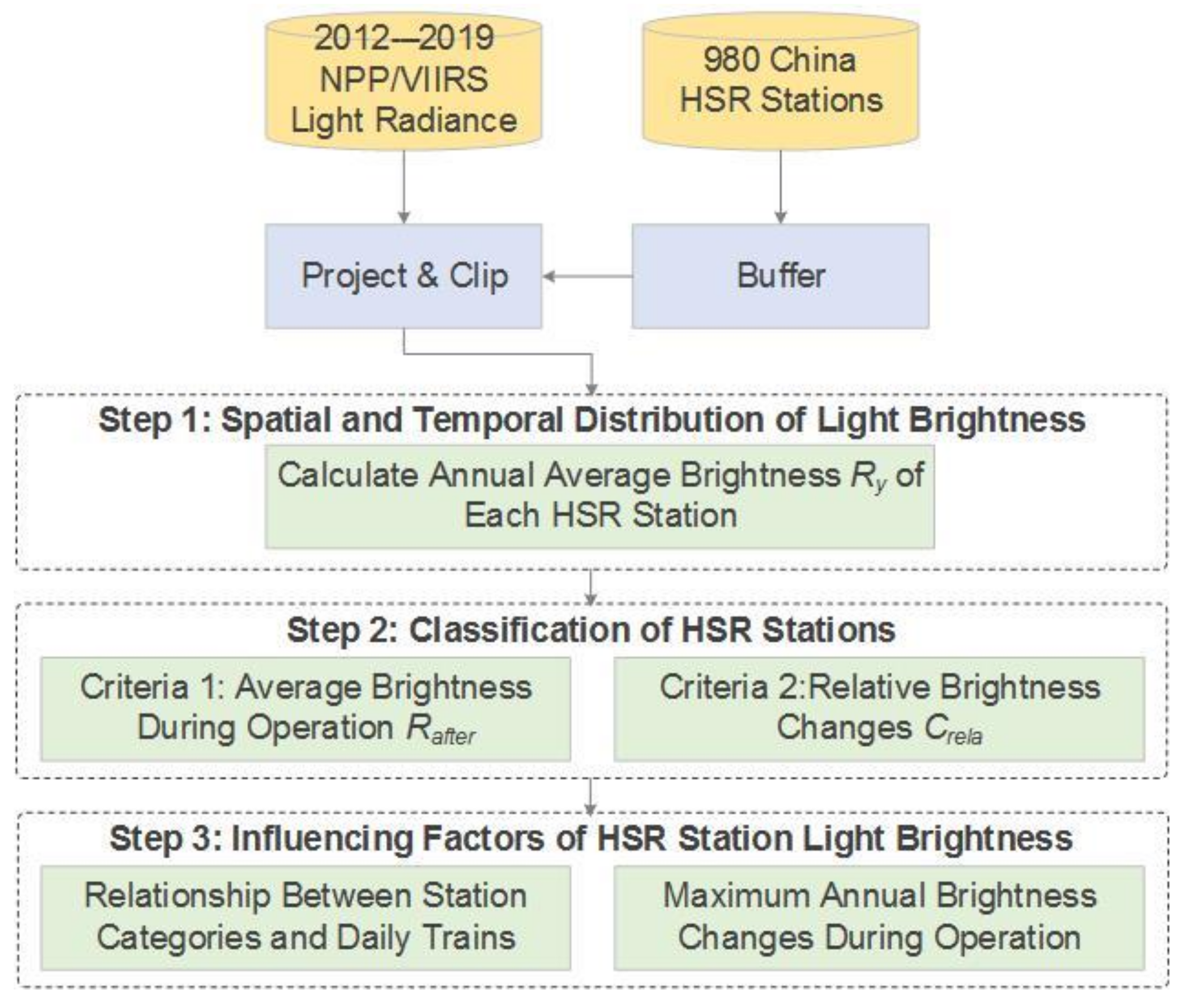

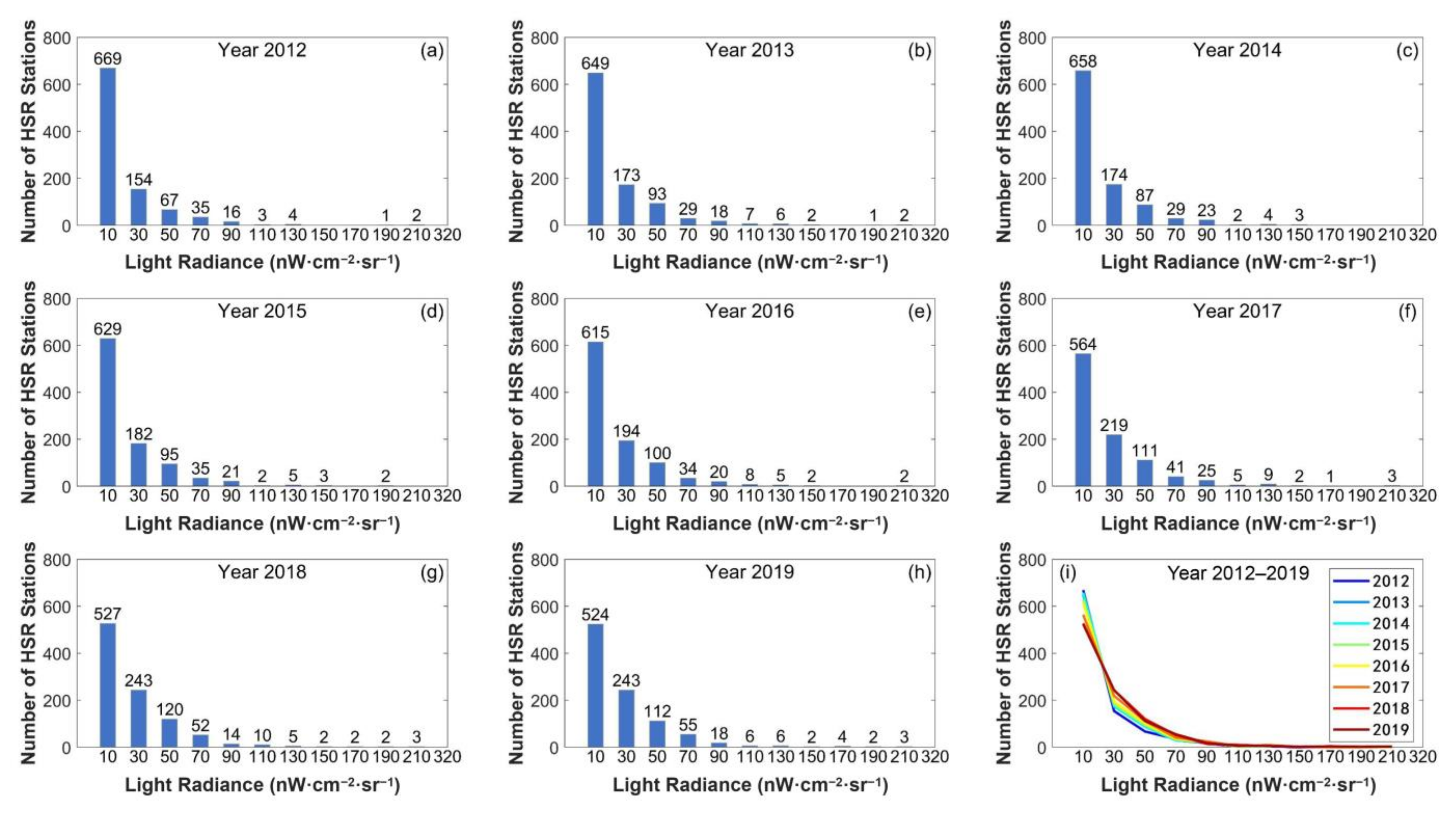
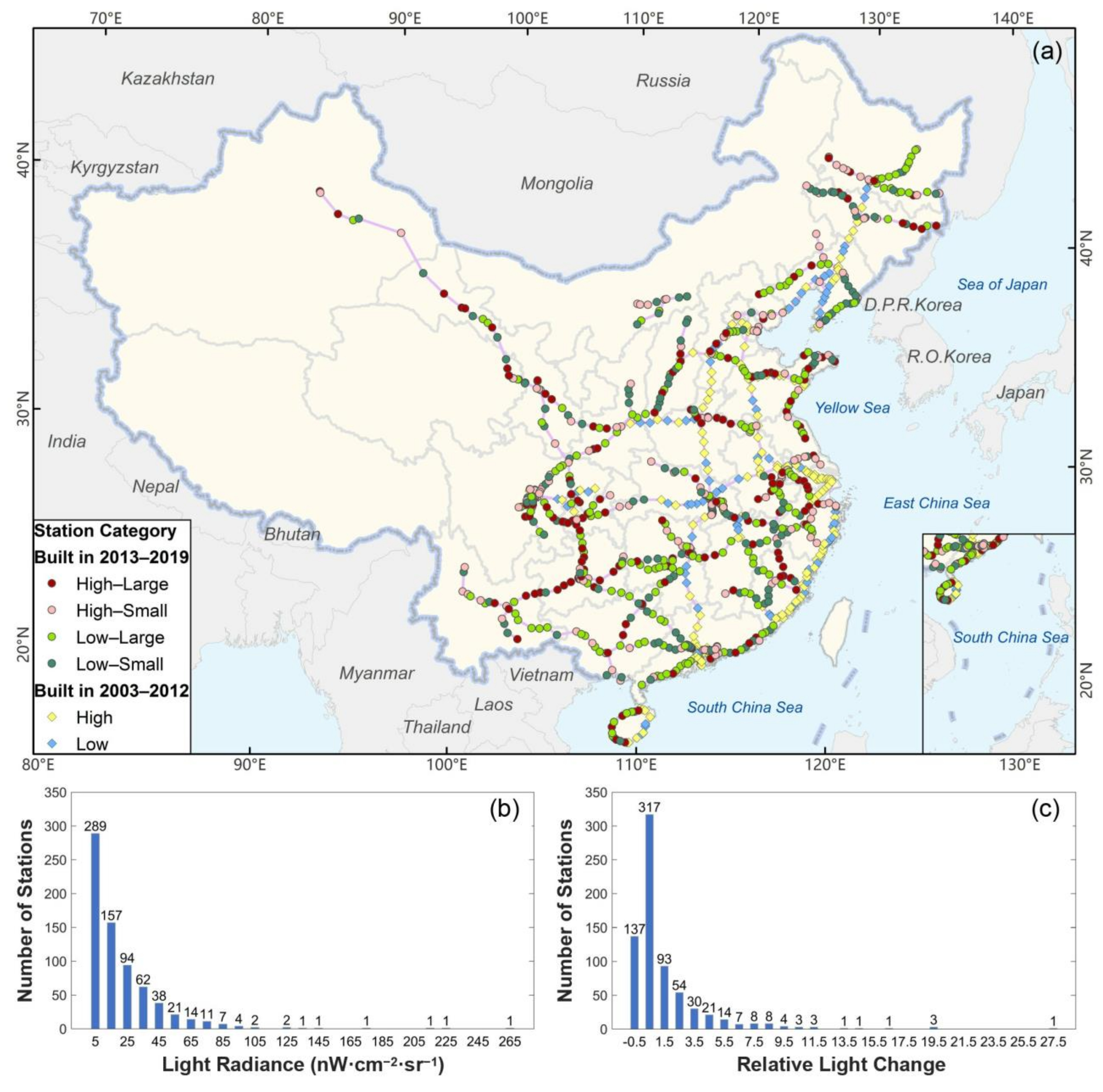
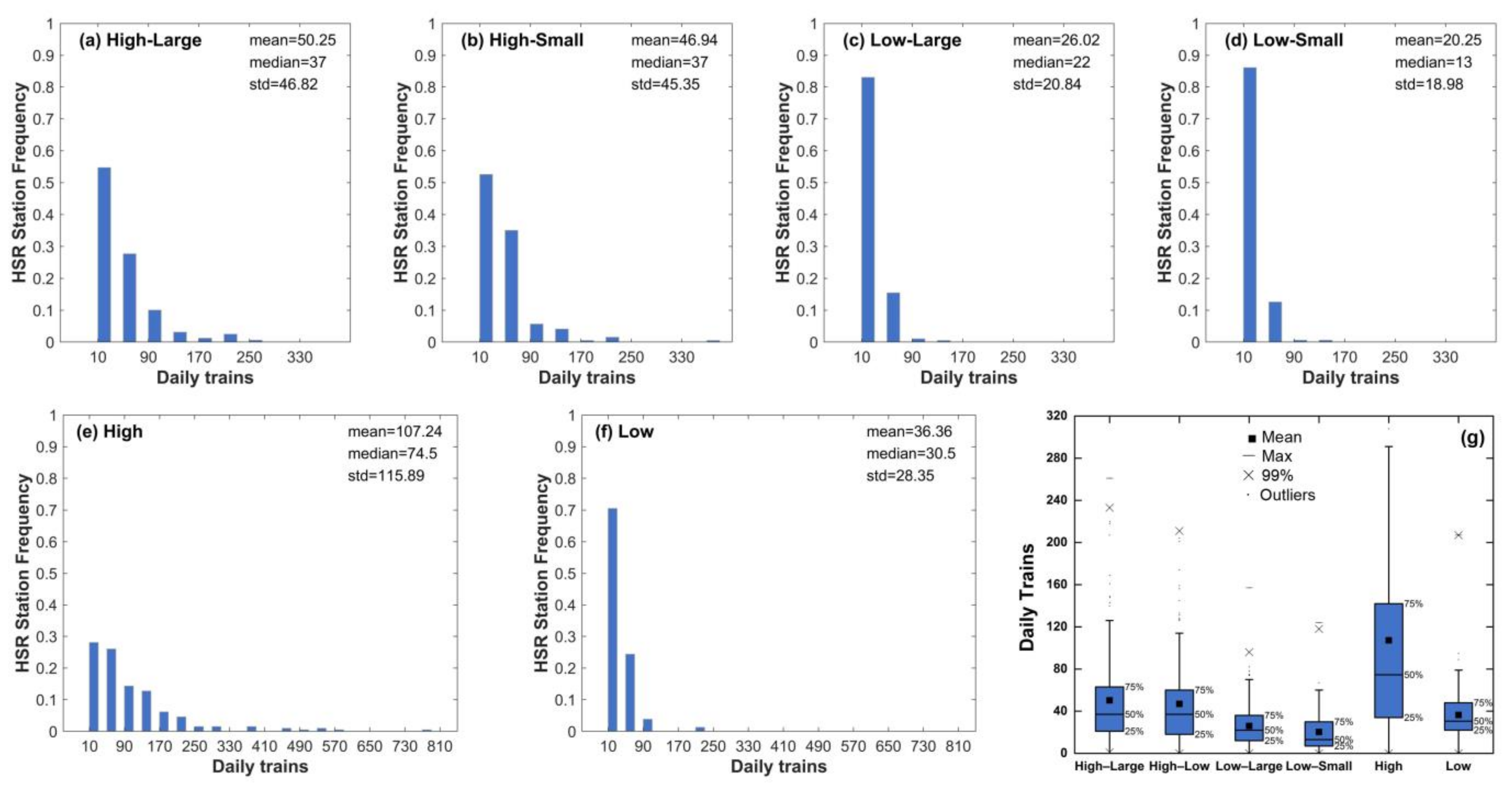
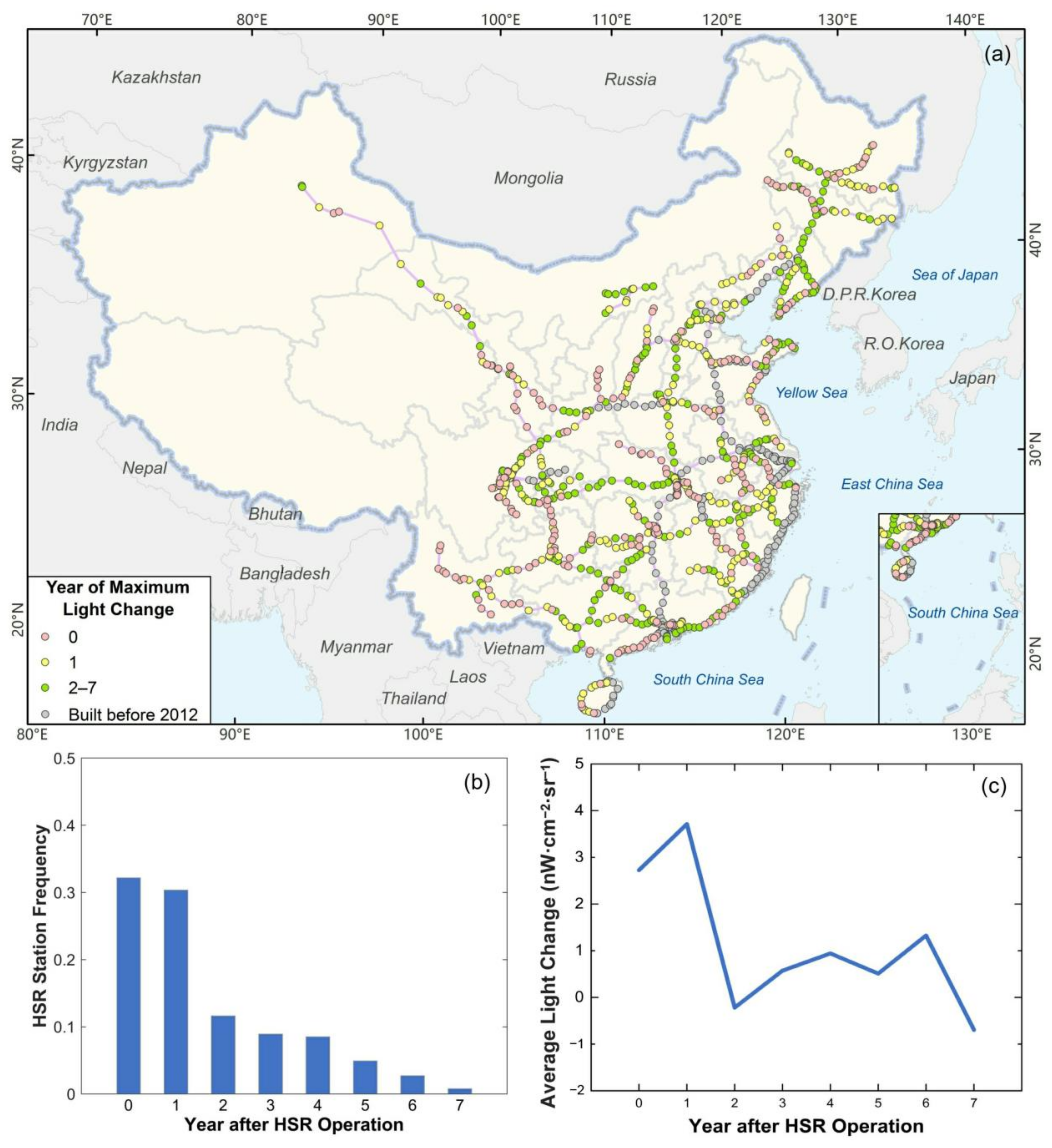
| Year | t | t + 1 | …… | 2019 |
|---|---|---|---|---|
| Years of operation k | 0 | 1 | …… | 2019 − t |
| Annual brightness changes Ck | / | Rt+1 − Rt | …… | R2019−t − R2018−t |
| Line Code | Line Name | Average Brightness | Maximum Brightness | Station with Maximum Brightness | Number of Stations | Number of Stations over 60 nW·cm−2·sr−1 |
|---|---|---|---|---|---|---|
| v1 | Beijing –Guangzhou –Shenzhen | 36.72 | 319.23 | Futian | 44 | 6 |
| v2 | Beijing –Shanghai | 42.01 | 146.83 | Shanghai Hongqiao | 43 | 11 |
| v3 | Beijing –Harbin –Dalian | 44.50 | 172.57 | Liaoyang | 46 | 14 |
| v4 | Hangzhou –Shenzhen | 29.29 | 73.87 | Puning | 65 | 5 |
| h1 | Qingdao –Shijiazhuang –Taiyuan | 32.51 | 77.07 | Jinan East | 24 | 3 |
| h2 | Xuzhou –Lanzhou | 29.95 | 130.49 | Xi’an North | 33 | 3 |
| h3 | Shanghai –Wuhan –Chengdu | 30.17 | 85.49 | Hankou | 34 | 5 |
| h4 | Shanghai –Kunming | 20.40 | 78.74 | Kunming South | 46 | 2 |
Publisher’s Note: MDPI stays neutral with regard to jurisdictional claims in published maps and institutional affiliations. |
© 2021 by the authors. Licensee MDPI, Basel, Switzerland. This article is an open access article distributed under the terms and conditions of the Creative Commons Attribution (CC BY) license (http://creativecommons.org/licenses/by/4.0/).
Share and Cite
Du, Z.; Wu, W.; Liu, Y.; Zhi, W.; Lu, W. Evaluation of China’s High-Speed Rail Station Development and Nearby Human Activity Based on Nighttime Light Images. Int. J. Environ. Res. Public Health 2021, 18, 557. https://doi.org/10.3390/ijerph18020557
Du Z, Wu W, Liu Y, Zhi W, Lu W. Evaluation of China’s High-Speed Rail Station Development and Nearby Human Activity Based on Nighttime Light Images. International Journal of Environmental Research and Public Health. 2021; 18(2):557. https://doi.org/10.3390/ijerph18020557
Chicago/Turabian StyleDu, Zhenyu, Wei Wu, Yongxue Liu, Weifeng Zhi, and Wanyun Lu. 2021. "Evaluation of China’s High-Speed Rail Station Development and Nearby Human Activity Based on Nighttime Light Images" International Journal of Environmental Research and Public Health 18, no. 2: 557. https://doi.org/10.3390/ijerph18020557
APA StyleDu, Z., Wu, W., Liu, Y., Zhi, W., & Lu, W. (2021). Evaluation of China’s High-Speed Rail Station Development and Nearby Human Activity Based on Nighttime Light Images. International Journal of Environmental Research and Public Health, 18(2), 557. https://doi.org/10.3390/ijerph18020557






